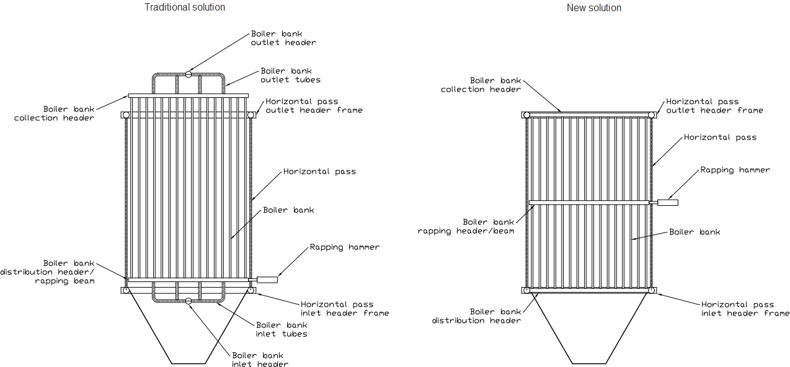- News
At Sumitomo SHI FW (SFW), we believe in pushing the boundaries of what is possible. We are now thrilled to share with you information about our invention that drives forward the development of heat exchange technology for boilers by streamlining processes, reducing costs, and enhancing efficiency.
The core of the invention lies in harnessing the power of natural circulation while removing the complexities associated with forced circulation pumps and heat exchanger setups. Behind the invention is a team of four SFW experts, Principal Engineer Jussi Pollari, Principal Engineer Mikko Ahvenainen, Lead Designer Asko Vartiainen and Quality Manager Hannu Poikonen, with top-level knowledge and long backgrounds in conceptual design, boiler design and quality at SFW. Read more about heat exchanger efficiency and cost savings that can be reached via using SFW’s rapping hammer solution:
The utilization of natural circulation in horizontal passes provides benefits in terms of simplicity. Forced circulation pumps are not needed, which lowers the overall cost and reduces maintenance need. However, natural circulation requires constant up-flow of fluid.
Rapping hammers enhance the cleaning of heat exchangers
With highly fouling fuels, the typical solution for cleaning heat exchanging surfaces is to use rapping hammers. The use of rapping hammers provides impact to a heat exchanger surface and causes the tubes of the heat exchanger surface to vibrate. This vibration then dislodges build-ups in the tubes and provides better heat transfer. The removed material is typically collected into an ash hopper, where ash handling devices transfer the collected ash for further processing. For this to happen, the tubes must be flexible enough to have the necessary vibration without causing damage which a too rigid arrangement might enable.
An integrated design
The traditional solution has been to have a separate horizontal pass where the heat exchanger is hung. The horizontal pass and heat exchanger have been split into separate inlets with piping and then again collected to the same pipe from separate outlets. In natural circulation, the roof is typically an uncooled structure that requires mitigation for temperature and thermal movement management. Also, the height of structure is increased due to the requirements for the hanging of heat exchanger surfaces and a separate inlet and outlet therebetween.
Efficiency meets simplicity
In the new solution, rapping hammers are located at about mid-height of the heat exchanger surface, which enables a simplified arrangement. Both the horizontal pass and the heat exchanging surface can share the same inlet and outlet. This reduces the need for separate piping for the horizontal pass and heat exchanger inlets and outlets, as they can be combined. Besides, the height of the structure is reduced as room is not required for feed tubing inside pass for heat exchanger surfaces.
The arrangement also enables the use of a cooled roof structure and removes the need for a complicated uncooled roof arrangement with high-grade materials. Up to a certain size, the arrangement also allows a simplified supporting method as separate support is not needed in the integrated structure. Moreover, placing rapping beams in the middle further renders the possible cooling of the rapping beams by having heat exchanger tubes go therethrough.
The picture below illustrates the differences between the traditional and new solution.

For further information please contact:
Principal Engineer Jussi Pollari
[email protected]
tel. +358 44 3503285
Sumitomo SHI FW


